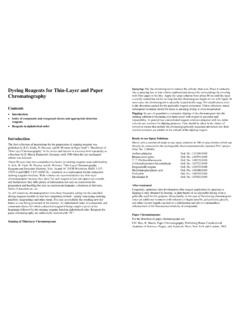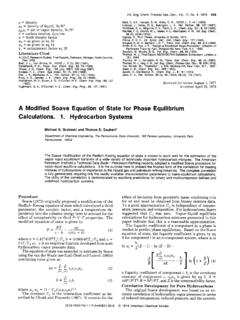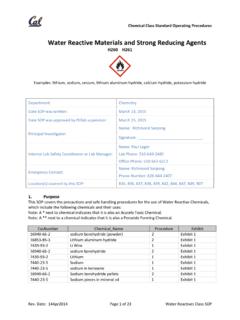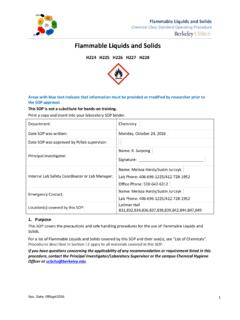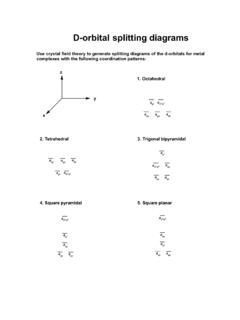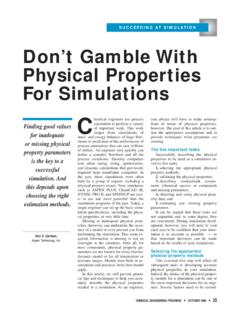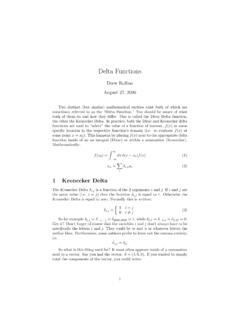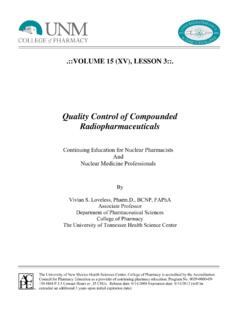Transcription of Visualizing the McCabe-Thiele Diagram
1 36 December 2009 CEPR eactions and SeparationsPaul M. MathiasFluor this spreadsheet-based visualization and interactive analysis of the McCabe-Thiele Diagram to understand the foundations of distillation the McCabe-Thiele DiagramMore than 80 years ago, McCabe and Thiele developed a creative graphical solution tech-nique based on Lewis s assumption of constant molal overfl ow (CMO) for the rational design of distilla-tion columns (1). The McCabe-Thiele Diagram enabled decades of effective design and operational analysis of distillation columns, and has been used to teach several generations of chemical engineers to design and trouble-shoot distillation and other cascaded processes.
2 Simplifi ed methods such as McCabe-Thiele are rarely used today for detailed design. Modern tools are based on rigorous solution of the equations governing cascaded separations, and properly deal with multicomponent sys-tems, heat effects, chemical reactions and mass-transfer limitations (2). Commercially available software enables simulation of entire chemical plants for the purposes of design, optimization and control but it is important to ensure the discriminating and competent use of these sophisticated tools. The McCabe-Thiele visual approach provides a powerful way to attain this judgment and competency.
3 Software applications based on rigorous calculations do not explain how distillation really works and how the numerous process variables interact to yield a distilla-tion column that is energy effi cient, stable, and produces products with the desired purities. If the design engi-neer specifi es an impossible set of inputs, even the best commercial software either crashes or returns vague and unhelpful messages ( , Tray j dried up ). Engineers who have only performed simulations resort to arbitrary and frantic changes in input variables to obtain a simula-tion with a feasible specifi cation.
4 In addition, rigorous, computerized calculations do not reveal design problems such as composition pinches and unforgiving composition profi les ( , a steep peak in the composition profi le of one or more components in multicomponent distillation) until they are converged. For these reasons, textbooks on staged separations stress the visual approach and present the McCabe-Thiele Diagram as an essential tool for under-standing and analyzing cascaded operations. Experienced process engineers often use McCabe-Thiele diagrams to understand or help debug simulation results (3).
5 Yet some consider graphical techniques tools of the past, and as a result, the distillation column has become a black box and engineers understanding of distillation has suffered (4). Even though the construction of McCabe-Thiele dia-grams is straightforward, it is a tedious and error-prone process. Hence, engineers rarely study the large number of cases needed to understand the interactions of the many process variables. This article introduces a spreadsheet-based approach that readily produces McCabe-Thiele diagrams for binary systems so that the interacting effect of process vari-ables can be visualized easily and interactively; the Excel fi le is provided as a supplement to the online version of this arti-cle ( ).
6 Because it is based on the widely available Excel software and uses standard techniques, this method is a useful advance over existing software tools that enable visualization of the McCabe-Thiele Diagram . Excel spreadsheets are increasingly used in chemical engineering education and industrial practice (5). This article demonstrates how Excel may be used for chemical engineering computation and visualization. Through the example presented in the sidebar, the article also demon-strates how the McCabe-Thiele method, and, in particular, the spreadsheet application introduced here, answers typi-cal design December 2009 37 The approach As far as possible, this application uses Excel s standard capabilities.
7 The exception is a function to perform data interpolation, called Interp, which was developed using Visual Basic for Applications (VBA) and is provided as part of the online version of the article. This function is used, for example, to interpolate vapor-pressure and x-y equilibrium data. This feature enables the spreadsheet application to accept x-y data from any source, including experimental data, calculated values derived from a thermodynamic model, or values from commercial software. Figure 1 is a schematic Diagram of a distillation col-umn with a total condenser and a partial reboiler.
8 The par-tial reboiler is an equilibrium stage, but the total condenser is not. The stages are counted from the top down, with stage 1 at the top of the column where the refl ux enters. (Note that if a partial condenser is used, it will have to be counted as the fi rst equilibrium stage.) According to the CMO approximation, each stage is at phase equilibrium, and the vapor and liquid fl ows are constant in both the rec-tifying section (above the feed tray) and the stripping sec-tion (feed tray and below). Following the usual practice, the compositions refer to the more-volatile component.
9 The vapor and liquid fl ows in the rectifying section (above the feed tray) are denoted as V and L, respectively. The equations resulting from the McCabe-Thiele technique are available in textbooks on separations and are only summarized here. The constant vapor and liquid fl ows resulting from the CMO approximation lead to the following component-balance equation (or operating line) in the rectifying section: ()yxVLxVL11jjD1=+-+^h The relationship between the refl ux ratio (R = L/D) and the liquid-to-vapor fl ow ratio (L/V) is: RRVL12=+^h Analogous to Eq.
10 1, the operating line for the strip-ping section is: ()yVLxVLx13jjB1=+-+^h The feed line, or q-line, starts from a point on the x = y diagonal line where x = xF and has a slope based on q or the liquid fraction of the feed. In the distillation literature, q is usually referred to as the thermal state of the feed. Note that q can be less than zero (superheated vapor) or greater than unity (subcooled liquid). The slope of the q-line is q/(q 1). The construction of the two operating lines and the q-line is performed in Excel as follows: 1. The rectifying-section operating line is drawn using Eqs.
